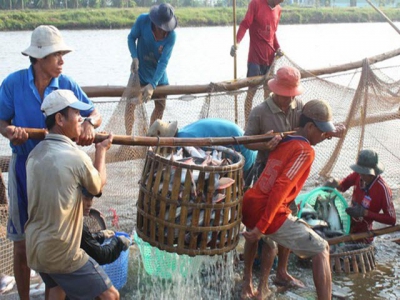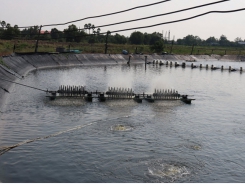Aquatic exports expected to decline by 1.2 percent

According to the Directorates of Fisheries, aquaculture industry has encountered some disadvantages such as commodity prices in the world changed complicatedly and trade dispute between the US and China escalated, affecting export; the price of material aquatic products dropped; fishing vessels and fishermen still violated illegal, unreported and unregulated fishing regulations; although authorities struggled to implement solutions, yellow card of European Commission on Vietnamese wild-caught seafood has not been removed.
Due to several difficulties, aquatic exports of Vietnam this year is forecast to drop by 1.2 percent over the previous year.
However, the advantage for aquaculture and fishing was favorable weather. Driftnet fishing had average production efficiency, seine fishing was stable while squid and tuna fishing were quite effective. Diseases on farmed aquatic products did not outbreak thanks to good prevention.
By the end of October this year, aquatic product export turnover was estimated to exceed US$7 billion, a decrease of 2 percent over the same period last year, of which, shrimp exports reached $2.78 billion, down 6.4 percent, and pangasius fish exports touched $1.64 billion, down 10 percent. Export of aquatic products of Vietnam declined as some countries, such as India and Ecuador continued to have a bumper crop of shrimps. With plentiful shrimp supply and low cost prices, they were able to compete with Vietnamese shrimps. China tightened cross border trade, increased control on quality, food safety and origin traceability while some Vietnamese enterprises were subjective so they did not meet the requirements.
As for pangasius fish, export of pangasius fish to major markets like the US and China started to drop since March this year so enterprises also reduced purchase of material pangasius fish. Some countries, including Indonesia, China and Bangladesh have invested in pangasius fish, especially Indonesia which has begun to build and publicize product line of clean pangasius fish and dominate markets in the Middle East. Arab Saudi still closes their doors to Vietnamese aquatic products, including pangasius fish. All those disadvantages have caused the price of material pangasius fish to plummet to VND19,000-VND19,500 per kilogram for first grade pangasius fish, making several pangasius farming households to suffer huge losses.
Deputy minister Phung Duc Tien of the Ministry of Agriculture and Rural Development said that aquatic products play an important role in agricultural production and export; however, the industry has been facing several difficulties. The yellow card on wild-caught seafood has made nearly 100 percent of shipments of Vietnamese seafood exporters to be checked and the prolonged inspection duration is costly. Besides, aquatic farming models are sluggish in changing, remain in small scale and lack of linkage. Infrastructure for fisheries is weak, outdated and lacks of investment, post-harvest losses are fairly high. Supply chain in fisheries activities is still fragmented while there is a shortage of high-quality human resource in fisheries industry. These shortcomings have lasted for several years that need to be tackled quickly.
The Vietnam Association of Seafood Exporters and Producers (VASEP) said that it has been collaborating with relevant departments and enterprises to promote seafood exports as much as possible during last month of this year. It is forecast that aquatic exports might reach $2.44 billion in the last quarter of this year, raising total aquatic exports of this year to $8.7 billion, a decrease of 1.2 percent over last year.
In long term, the VASEP recommended that shrimp industry should quickly create certified clean shrimp source at competitive prices, thereby building the brand name of Vietnamese shrimps. In order to do this, it is necessary to arrange and plan reasonable shrimp farming areas, establish large-scale farms and cooperatives that meet global standards so as to get certification. Authorities should invest in infrastructure of farming areas, focusing on electricity, road and irrigation.
As for pangasius fish, it is essential to review farming areas so as to avoid excess in material pangasius fish, build sufficient database in order to assess the situation, apply digitalization and provide directional information for pangasius development. Authorities should control well from fingerling stage to improve pangasius fish quality to meet requirements of choosy markets. In the near future, pangasius fish export to China through cross border trade will be reduced and official export of pangasius fish will be increased. At the same time, the industry needs to have marketing strategy and promote export to the EU market.
Có thể bạn quan tâm
Phần mềm

Phối trộn thức ăn chăn nuôi

Pha dung dịch thủy canh

Định mức cho tôm ăn

Phối trộn phân bón NPK

Xác định tỷ lệ tôm sống

Chuyển đổi đơn vị phân bón

Xác định công suất sục khí

Chuyển đổi đơn vị tôm

Tính diện tích nhà kính

Tính thể tích ao hồ




 How aquaculture producers can benefit from a “beyond…
How aquaculture producers can benefit from a “beyond…  Double standards: why the sustainable seafood narrative needs…
Double standards: why the sustainable seafood narrative needs…